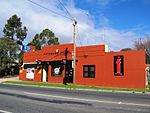City of Bendigo
Former local government areas of Victoria (state)Use Australian English from August 2019

The City of Bendigo was a local government area covering the central area and inner western suburbs of the regional city of Bendigo, Victoria, Australia. The city covered an area of 32.53 square kilometres (12.6 sq mi), and existed from 1855 to 1994.
Excerpt from the Wikipedia article City of Bendigo (License: CC BY-SA 3.0, Authors, Images).City of Bendigo
Bannerman Street, Bendigo
Geographical coordinates (GPS) Address Nearby Places Show on map
Geographical coordinates (GPS)
| Latitude | Longitude |
|---|---|
| N -36.75 ° | E 144.26666666667 ° |
Address
Bannerman Street
Bannerman Street
3550 Bendigo (Bendigo)
Victoria, Australia
Open on Google Maps





